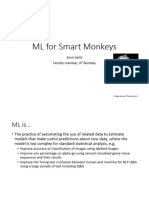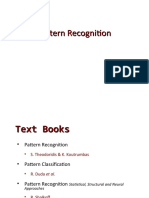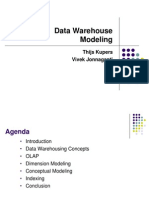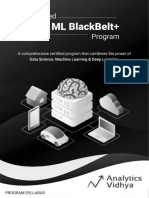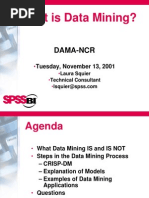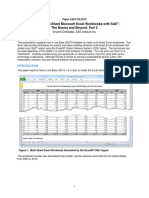0 ratings0% found this document useful (0 votes)
12 viewsLecture 4 - Deep Learning Introduction
Uploaded by
Prena Manohar Lal LalwaniCopyright
© © All Rights Reserved
Available Formats
Download as PPTX, PDF, TXT or read online on Scribd
0 ratings0% found this document useful (0 votes)
12 viewsLecture 4 - Deep Learning Introduction
Uploaded by
Prena Manohar Lal LalwaniCopyright
© © All Rights Reserved
Available Formats
Download as PPTX, PDF, TXT or read online on Scribd
You are on page 1/ 63
Deep Learning —
Introduction, Keras Intro,
Tensor Manipulation
Machine Learning
Sher Muhammad Daudpota
Sukkur IBA University
AI, Machine Learning and Deep
Learning
Deep Learning
• Deep Learning is subfield of Machine Learning
• Layered representation of learning
• Hierarchical representation of learning
• “Deep” in Deep Learning is number of layers or depth of hierarchy
• Layered representation is learned through neural network
• Remember people will say neural networks are modeled the way
human brain works, but believe me that is not the truth…
Deep Learning
Deep Learning
Deep Learning
• Three important things in deep learning,
• Weights
• Loss Function
• Optimizer
Deep Learning: Weights
Deep Learning: Loss Function
Deep Learning: Optimizer
Deep Learning Wonders So far..
Deep Learning Wonders So far..
What makes deep learning different
or so successful?
• Feature Engineering
• DL automates it
Why Deep Learning Now?
• Hardware
• GPU, NVIDIA’s CUDA and TITAN X
• Google’s TPU (Tensor Pro…..)
• Datasets and benchmarks
• Algorithmic advancements
• Better activation functions
• Weight initialization schemes
• Optimization schemes
Let’s run MNIST hand written digits
recognition..
Hello World of Deep Learning
Data Representation for Tensors
• Tensor is a container for data, mostly numerical data
• Matrices are 2D tensors
• Scalars
• Tensor with only one number
• 0D tensor
Data Representation for Tensors
• Vectors
• 1D tensors
Data Representation for Tensors
• Matrices (2D tensors)
• Array of vectors
Data Representation for Tensors
• 3D tensor
Data Representation for Tensors
• Tensor Key Attributes
• Number of axes: that is returned through ndim
• Shape: define dim along each axis and returned through shape
• Data type: It can be float32, uint8, int32, float64 and char
Data Representation for Tensors
• Real-world tensors examples
Data Representation for Tensors
• Vector Data
Data Representation for Tensors
• Timeseries data (3D tensor)
Data Representation for Tensors
Data Representation for Tensors
• Image Data (4D tensors)
• A batch of 128 grayscale images of size
256 x 256 can be stored in a tensor of
shape (128,256,256,1)
• A batch of 128 color images could be
stored in a tensor of shape
(128,256,256,3)
Data Representation for Tensors
• Video Data (5D tensors)
Data Representation for Tensors
• Example
• ndim
• Shape and dtype
Data Representation for Tensors
Data Representation for Tensors
• Tensor slicing is selecting specific elements in an tensor,
Data Representation for Tensors
• Data batches
MNIST Complete Example
Classifying movie reviews (IMDB
Practical)
Classifying newswire: A multiclass
classification (practical)
Playing with BBC dataset
Assignment
• Available on eLearning
• Tweet Emotion Classification
• BBC Sports News Classification (try doing it in class, if time permits)
Fundamentals of Machine Learning
• Four Branches of Machine Learning
• Supervised Learning
• Sequence Generation
• Syntax Tree Prediction
• Object Detection
• Image Segmentation
• Unsupervised Learning
• Dimensionality Reduction
• Clustering
• Self Supervised Learning
• Reinforcement Learning
Evaluating Machine Learning Models
• Training set
• Validation Set
• Test Set
Simple Hold Out Validation
Simple Hold Out Validation
K-Fold Validation
Keep in mind….
• Data Representation in Cross Validation
• Arrow of time
• Redundancy in your data
Data Preprocessing, feature
engineering and feature learning
• Preprocessing
• Vectorization
• Value normalization
• Handling missing values
• Feature Engineering
Overfitting, Underfitting,
Optimization, Generalization
• Regularization
• Process to fight overfitting
• Too much capacity vs memory starvation
Overfitting, Underfitting,
Optimization, Generalization
Overfitting, Underfitting,
Optimization, Generalization
Overfitting, Underfitting,
Optimization, Generalization
Overfitting, Underfitting,
Optimization, Generalization
Regularization
Regularization
Regularization
Regularization
• Adding dropout
Regularization
• Adding dropout
Regularization
To fight with overfitting, increase
generalization and discourage
optimization..
• Get more training data
• Reduce network capacity
• Add weight regularization
• Add dropout
Universal Workflow of Machine
Learning Problems
• Define problem and dataset
• Data inputs outputs
• Binary classification, regression, multiclass?
• Non-stationary data consideration
Universal Workflow of Machine
Learning Problems
• Choosing a measure of success
• Accuracy for class-balance problems
• Precision and recall for class-imbalance problems
Universal Workflow of Machine
Learning Problems
• Deciding on an evaluation protocol
• Hold out cross validation: loads of data available
• K-Fold cross validation: too few samples for hold out cross validation
• Iterated K-Fold: for high accurate model too little data, say in 100s
Universal Workflow of Machine
Learning Problems
• Preparing your data
• Covert data in tensors
• Range data to [-1,1] or [0,1]
• Normalize all features, bring to same range
• Feature engineering if required
Universal Workflow of Machine
Learning Problems
• Developing a model that does better than baseline
• Random classification accuracy 0.5
Universal Workflow of Machine
Learning Problems
Universal Workflow of Machine
Learning Problems
Universal Workflow of Machine
Learning Problems
• Scaling up: developing a model that overfits
• Cross the border that exists between optimization and generalization
• Border between overfitting and underfitting
Universal Workflow of Machine
Learning Problems
• Regularizing your model and tuning hyper parameters
• This step deserve your highest attention
You might also like
- Ai - Introduction: FDP / Short Term Training On Artificial Intelligence & Deep Learning ApplicationsNo ratings yetAi - Introduction: FDP / Short Term Training On Artificial Intelligence & Deep Learning Applications6 pages
- CSC 3301-Lecture06 Introduction To Machine LearningNo ratings yetCSC 3301-Lecture06 Introduction To Machine Learning56 pages
- Machine Learning, AI & Its Applications: Live Online Instructor-Led Training OnNo ratings yetMachine Learning, AI & Its Applications: Live Online Instructor-Led Training On6 pages
- Certified Data Scientist Master's ProgramNo ratings yetCertified Data Scientist Master's Program11 pages
- Lecture-01, Adv. Computer Architecture, CS-522No ratings yetLecture-01, Adv. Computer Architecture, CS-52243 pages
- Informa) CS: Lecture 6 - Processing Informa4onNo ratings yetInforma) CS: Lecture 6 - Processing Informa4on29 pages
- Data Preprocessing and Data Analysis using PythonNo ratings yetData Preprocessing and Data Analysis using Python32 pages
- CS3491 - Aiml - Unit Iii Supervised LearningNo ratings yetCS3491 - Aiml - Unit Iii Supervised Learning162 pages
- Networks Security Quiz - March 2024 With AnswersNo ratings yetNetworks Security Quiz - March 2024 With Answers8 pages
- Device Load Monitor With Programmable Meter For Energy AuditNo ratings yetDevice Load Monitor With Programmable Meter For Energy Audit3 pages
- 5 Digital Transformation Challenge Unique To Consulting PDFNo ratings yet5 Digital Transformation Challenge Unique To Consulting PDF15 pages
- Chaka HR Digitalization - Deck v2.1.052023No ratings yetChaka HR Digitalization - Deck v2.1.05202339 pages
- IOT Based Soil Moisture, Temperature and Humidity Measurement Using ArduinoNo ratings yetIOT Based Soil Moisture, Temperature and Humidity Measurement Using Arduino42 pages
- Red Hat Enterprise Linux-9-Deploying Web Servers and Reverse proxies-en-USNo ratings yetRed Hat Enterprise Linux-9-Deploying Web Servers and Reverse proxies-en-US44 pages
- 1.3) BC-6000 Hardware System - Service TrainingNo ratings yet1.3) BC-6000 Hardware System - Service Training31 pages
- SAS1700-2015 - Creating Multi - Sheet Microsoft Excel Workbooks With SAS - Part 2No ratings yetSAS1700-2015 - Creating Multi - Sheet Microsoft Excel Workbooks With SAS - Part 221 pages
- Week01 - EHE Module 01 Information Security FundamentalsNo ratings yetWeek01 - EHE Module 01 Information Security Fundamentals29 pages
- Biomedical Signal Processing and Control: Sajjad Afrakhteh, Hamed Jalilian, Giovanni Iacca, Libertario DemiNo ratings yetBiomedical Signal Processing and Control: Sajjad Afrakhteh, Hamed Jalilian, Giovanni Iacca, Libertario Demi11 pages
- Ai - Introduction: FDP / Short Term Training On Artificial Intelligence & Deep Learning ApplicationsAi - Introduction: FDP / Short Term Training On Artificial Intelligence & Deep Learning Applications
- CSC 3301-Lecture06 Introduction To Machine LearningCSC 3301-Lecture06 Introduction To Machine Learning
- Machine Learning, AI & Its Applications: Live Online Instructor-Led Training OnMachine Learning, AI & Its Applications: Live Online Instructor-Led Training On
- Device Load Monitor With Programmable Meter For Energy AuditDevice Load Monitor With Programmable Meter For Energy Audit
- 5 Digital Transformation Challenge Unique To Consulting PDF5 Digital Transformation Challenge Unique To Consulting PDF
- IOT Based Soil Moisture, Temperature and Humidity Measurement Using ArduinoIOT Based Soil Moisture, Temperature and Humidity Measurement Using Arduino
- Red Hat Enterprise Linux-9-Deploying Web Servers and Reverse proxies-en-USRed Hat Enterprise Linux-9-Deploying Web Servers and Reverse proxies-en-US
- SAS1700-2015 - Creating Multi - Sheet Microsoft Excel Workbooks With SAS - Part 2SAS1700-2015 - Creating Multi - Sheet Microsoft Excel Workbooks With SAS - Part 2
- Week01 - EHE Module 01 Information Security FundamentalsWeek01 - EHE Module 01 Information Security Fundamentals
- Biomedical Signal Processing and Control: Sajjad Afrakhteh, Hamed Jalilian, Giovanni Iacca, Libertario DemiBiomedical Signal Processing and Control: Sajjad Afrakhteh, Hamed Jalilian, Giovanni Iacca, Libertario Demi















